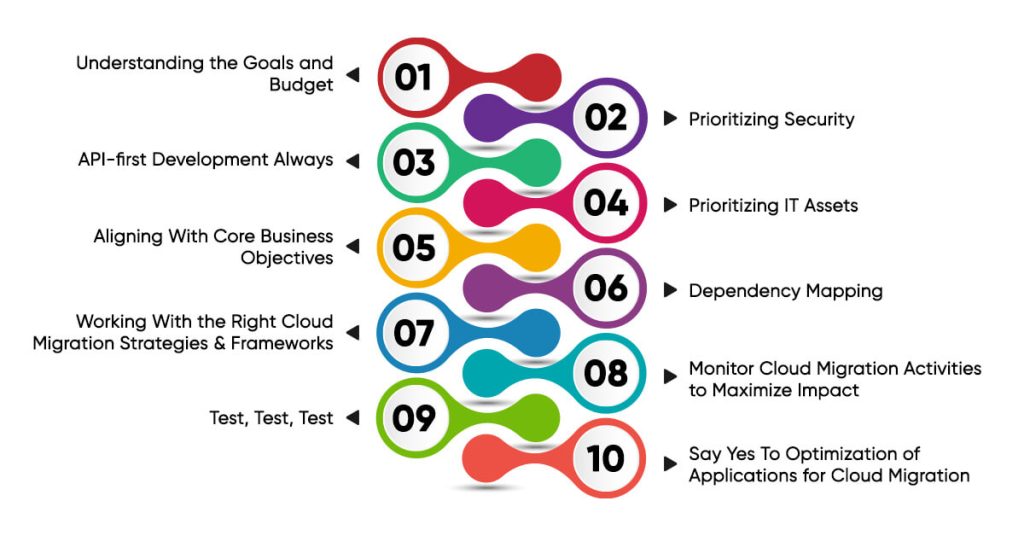Quick Summary
Cloud migration is a strategic approach that all forward-looking businesses are keeping on their top priority list in 2025 and beyond. Cloud infrastructure brings agility, scale, and faster access to business apps. It leads the transition from capital expenditure to operational expenditure models while eliminating the need for on-premises maintenance. However, before abandoning legacy systems for more scalable cloud solutions, it’s essential to understand both its advantages and complexities. Smoother transitions require careful planning and adherence to best practices.
Introduction
Whether you’re a startup or an established business, cloud migration service can be a game changer in creating a cost-effective and scalable IT infrastructure. However, before you transition to the cloud or hire experts for enterprise-level cloud migration, it’s critical to know the process’s pros and cons, ins and outs, and complexities. Going one step forward, it is better to know all the great strategies and best practices for cloud migration. As we write this, many organizations are considering the cloud, many are thinking of giving up on legacy and on-premise systems and moving to clouds that are multi-times scalable than most outdated legacy systems.
With external cloud vendors and cloud services by third parties, organizations that move to the cloud do not have to handle the technical aspects of their business applications anymore. From a technical perspective, it is a great benefit. However, a rushed and without ‘thought’ migration to the cloud can be a disaster. Therefore, you need to work out a lot of things before you go for cloud migration. Knowing the best practices of cloud migration can help. Also, hiring a professional cloud migration service provider can make it completely hassle-free.
In this blog, you’ll learn about the best practices for cloud migration, actionable insights, and how to choose the best cloud migration service.
Keep reading!
10 Cloud Migration Best Practices That Businesses Should Know

Cost reduction and infrastructure optimization packs surefire benefits for businesses. Cloud migration is by far the most plausible approach. Why? It allows organizations to shift from a capital expenditure model to an operational expenditure model. In doing so, companies dramatically reduce their need to own, operate, and maintain expensive equipment on-premises and across data centers.
No wonder cloud migration tops the list of forward-thinking businesses in 2025. And industry reports suggest it’s going to be in vogue for long. Reportedly, the global cloud computing market is poised for a CAGR growth of 17.5% by the end of 2025. So, whether your business needs Azure cloud migration or AWS cloud migration, it checks all the boxes for scalability, cost-effectiveness, and unmatched agility.
But like all good things on earth, cloud data migration has its fair share of challenges. From data security to legacy system integrations, things can be tricky, especially for businesses moving from on-premise to cloud solutions for the first time. Fret not! We’ve got your back.
Here’s a closer look at the industry’s best practices to make an impact.
1. Understanding the Goals and Budget
As a business owner, you know that a cloud-native model will always fetch you better results. However, you should always evaluate the costs before you commit to hiring a cloud migration service. If your primary objective for cloud migration is only to join the trend or realize stakeholder vision, then you can’t reap maximum benefits. That’s why before moving from on-premise to cloud, you should:
- Ensure the key business objectives align with broader strategies
- Conduct end-to-end cost-benefit analysis for tech expenses and staff training
- Assess your company’s readiness for cloud data migration
Cloud Migration Services You Can Choose:
Cloud Migration Design & Planning
| Cloud Application Migration
| Google Cloud Migration
|
AWS Cloud Migration
| Azure Cloud Migration
| Cloud Data Warehouse Migration
|
2. Prioritizing Security
When it comes to security, there should be no compromise at all. So, when planning for cloud data migration, always get a clear view of your security news well ahead of the integration. This is even more important if your business has been using a legacy system. Besides running the risk of sensitive data leakage, there are multiple legal requirements in place.
For example, suppose your business operates in the European Union. In that case, you’ll have to follow stringent GDPR guidelines to protect user data. For what matters, such security measures are easier to implement in the beginning compared to retrofitting them at the end of cloud migration.
Get end-to-end cloud migration services from planning & design to deployment and support with X-Byte Analytics!
3. API-first Development Always
When it comes to cloud migration, API-first development is the preferred approach for seamless cloud integration services and communication across multiple applications. If you’re a startup, API-first development is especially effective for moving from on-premise to the cloud.
- It allows engineers to have first-hand knowledge about the input and output formats for their preferred applications.
- It allows dependent teams to mock APIS and speed up development.
- It ensures that quality standards and corporate security measures are reviewed early and risks are mitigated beforehand.
- API-based architecture helps engineers bring about new enhancements without disrupting existing lines of services, relying on cloud APIs for unmatched agility and adaptability.
4. Prioritizing IT Assets
Assessment and prioritization of IT assets are necessary for cloud data migration. This is inarguably the most crucial phase to navigate. Thus, it makes sense to know the steps right.
Ideally, one should start by evaluating the suitability of applications before moving from on-premise to cloud. Key factors to consider include scalability, performance, and security.
However, not every application is suitable for cloud migration. This is where app categorization helps, allowing you to assess their complexity, importance, and readiness for cloud migration. It also allows you to identify several mission-critical apps that are vital to business operations alongside less complex ones to register early wins.
5. Aligning With Core Business Objectives
Once a business assesses the technical debt of each application, it can prioritize it to unleash the full potential of an app and optimize cloud migration needs. The best way to go about it is to line up the strategic goals that drive migration. It can be cost optimization, improved customer experience, or improved agility-whatever drives your business.
Once you align the cloud migration strategy with your core business objectives, there’s no looking back. It will ensure smart and effective resource utilization of resources for the best ROI.
A key thing to consider in this respect is also the technical assets. By evaluating cloud-native compatibility and integration points, the need for retargeting and refactoring of applications is also needed to leverage the full benefits of cloud data migration.
6. Dependency Mapping
Dependency mapping is all about having a comprehensive understanding and identification of intricate connections between IT infrastructure components and other applications. So, once you know how to map these dependencies, you can seamlessly create logical application groups (move groups) that share such common decencies for faster cloud migration. Here’s how to go about it.
- Start by interviewing the stakeholders and conducting a thorough assessment to discover hidden dependencies.
- Use automated discovery tools to accurately capture all dependencies.
- Steer clear of common pitfalls like underestimating interdependence complexity and overlooking legacy systems.
Remember, a comprehensive dependency map is a major step towards minimizing disruption and ensuring all relevant components are in place for successful migration planning. In doing so, it helps prioritize move groups and lessens critically for improved resource allocation and risk mitigation when moving from on-premise to cloud.
7. Working With the Right Cloud Migration Strategies & Frameworks
The right cloud migration strategy is everything. But to create one, you need a cloud migration roadmap that outlines clear milestones, timelines, and resources. All you need to do is follow a few simple steps.
- Assess all existing IT landscape needs, including data, applications, and infrastructure.
- Evaluate critical factors like dependencies and complexity.
- Select from a range of cloud migration strategies that include re-platforming, refactoring, and rebuilding.
- Develop migration roadmaps and outline the perfect sequence of migration activities.
- Prioritize IT needs according to core business objectives.
- Define clear milestones, timelines, and KPIs that will help you track organizational progress.
- Allocate resources matching your budget, personnel, and technology needs.
- Consider factors like training needs and skill gaps. And external support for smooth and hassle-free cloud-to-cloud migration
The 6 Rs of Cloud Migration
The 6 Rs provide a comprehensive framework for approaching cloud migration.
Strategy | Description | Best For |
Rehost | Lift-and-shift the application without changes | Legacy apps, quick migration |
Replatform | Make minor changes to take advantage of the cloud | Apps needing slight modernization |
Refactor | Redesign the application architecture | Apps requiring significant improvements |
Repurchase | Switch to a different product, often SaaS | Standardized processes, non-core apps |
Retain | Keep applications on-premises | Regulatory compliance, recent investments |
Retire | Decommission the application | Redundant or obsolete applications |
8. Monitor Cloud Migration Activities to Maximize Impact
The main challenge with cloud-native applications is that they leave you working with a distributed system. So, you must understand the health of the system at all times, which will help you create a scalable and robust monitoring system. Here are some of the key factors to consider.
- Always keep a log of aggregation to manage and centralize logs coming from multiple sources.
- Gain a comprehensive insight into all system events and activities.
- Create a robust APM (Application Performance Management) for seamless monitoring.
of performance metrics such as CPU usage, traffic patterns, memory availability, and error rates - Implement automated alerting mechanisms that can notify stakeholders every time the critical threshold exceeds
Remember, monitoring cloud migration is as important as embracing security, and you shouldn’t wait too long to start monitoring. You should be monitoring your cloud migration process right from the very beginning to gain maximum benefit.
9. Test, Test, Test
Whether it’s AWS or Azure cloud migration, there’s no alternative to consistent testing. Testing should be a prime concern at every stage of the process, from planning to development. With comprehensive testing, you can ensure all data function data functions and applications work as desired within your chosen cloud environment. Let’s take a look at some of the well-known testing types.
- Functional testing: When moving from on-premise to the cloud, always verify application performance for all intended functions. You should be spending time testing the interfaces, features, and integrations seamlessly.
- Performance testing: Testing your application performance under different conditions will help you identify existing bottlenecks and accordingly optimize resource allocation
- Scalability testing: The capability of an app to scale up or down when needed makes it an important consideration when moving from on-premise to the cloud. So, always ensure that your cloud migration system has an auto-scaling mechanism to handle a spike in traffic.
- Security testing: No cloud migration is successful without robust and functional security. That’s why security testing is emphasized to ensure compliance and identify potential vulnerabilities within the system. From data encryption to access control and authentication mechanisms, it makes sense to run rigorous security tests and safeguard sensitive information across all levels
Cloud migrations executed without hiccups! Hire X-Byte’s Cloud Migration Consulting Services Now!
10. Say Yes To Optimization of Applications for Cloud Migration
For businesses that want to harness the full potential of cloud migration, app optimization is a prerequisite. All cloud-native services, as well as features, promise unmatched scalability and performance. However, these applications need to be adapted better to fully leverage the benefits. Here’s what you need to do.
- Start by identifying core cloud-native services and features that readily align with application requirements.
- Utilize all managed services like AWS Lambda for serverless computing. Additionally, you can also go for containerization using Kubernetes for portability and effective scale-up.
- Test and fine-tune applications within your desired cloud environment, specifically to test efficiency and compatibility. In doing so, you can maximize resource utilization with effective configuration and modification of parameters that help lower costs and allocate resources effectively.
- Aim for re-architecture of legacy applications for cloud migration for long-term success. The first step is to break all monolithic applications into finer microservices to tick the boxes for agility and scalability. Thereon, it adapts to modern architecture that is primarily serverless and event-driven and helps optimize resource usage.
Choose the Right Cloud Migration Service Provider

Cloud migration can seem like a mammoth task, but not when you have the right service partner by your side. That way, a new business will never have to begin things from scratch. Furthermore, it can leverage a robust infrastructure by utilizing the best options like AWS cloud migration, Azure cloud migration, and Google Cloud. Here’s what you should be looking for when hiring the best cloud migration service provider.
- Check whether the cloud migration service provider has the mindset and capability to match your business goals and objectives.
- Consider key factors like compatibility with existing systems, reliability, and available services.
- Thoroughly evaluate the service provider’s track record, especially in terms of performance, security, and customer experience.
- Take time to study and understand the company’s pricing models and the range of services covered under their SLA.
Discover Game-Changing Cloud Migration Process With X-Byte Analytics
At X-Byte Analytics, we are more than a cloud migration service provider company. At the core of our operations, we understand that every cloud migration journey is different. Accordingly, we devise tailored solutions to reap maximum cloud migration benefits across key areas of your business. With handpicked industry professionals and an impeccable track record, we’ve helped several companies seamlessly shift from on-premise to cloud with a no-fuss approach.
If this sounds like something you need for your business, we would be more than happy to discuss your cloud migration plans.






